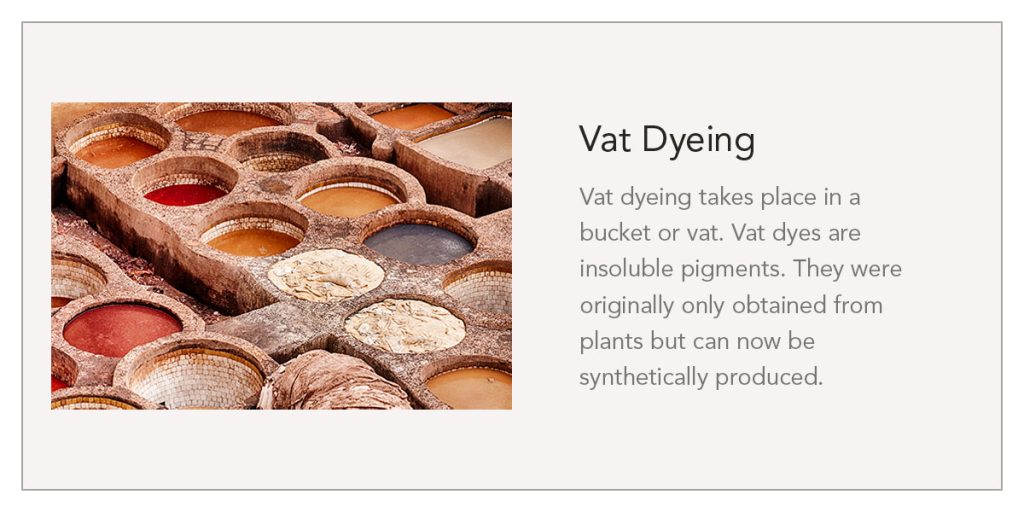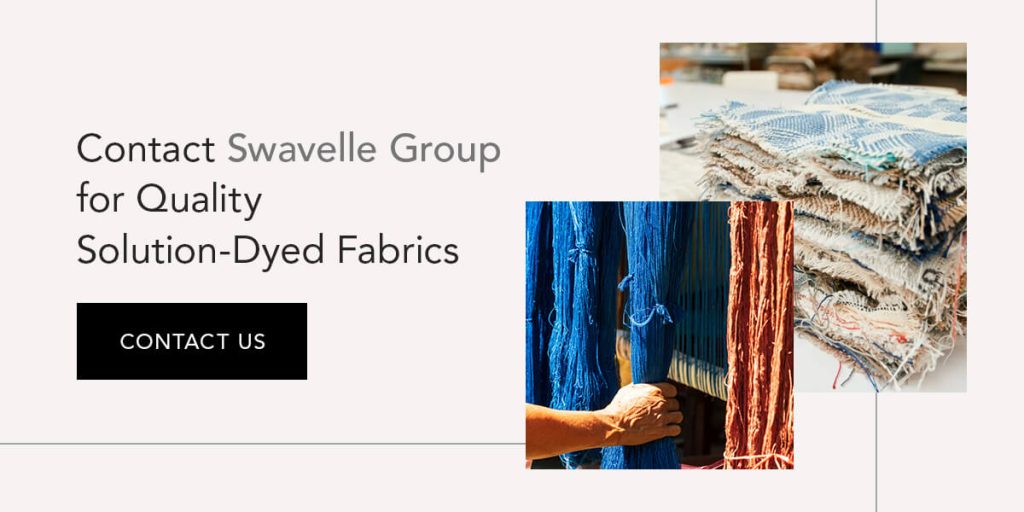Dyeing is the process of applying pigments to a yarn, fabric, garment or solution from which the fiber was made. It aims to create one or more colors, sometimes with a pattern or design.
There are many different types of dyeing techniques, each yielding a unique effect. Whether a solid color or intricate plaid, fabric dyeing can accomplish various applications. This guide explores some common textile dyeing methods and the different ways they attain color.
A broad range of methods can achieve successful dyeing of fabrics. Here are six different textile dyeing methods.
Batik is a type of resist dyeing, an ancient technique that prevents the dye from reaching all the cloth to form a pattern. Creating areas that resist the dye solution allows for lighter and darker colors in the same dyeing process.
Originating on the island of Java, Indonesia, batik is one of the oldest textile dyeing processes. It involves coating portions of fabric with wax, exposing only the unwaxed parts to the dye matter. The manufacturer may repeat this process multiple times using an array of colors for unique effects, like streaks or mottles.
Batik was traditionally designed for tailored garments and dresses. Today, it is used for various items, including quilting, clothing and wall hangings. Modern batik can also achieve brighter, more intricate patterns.
Here is the general process for batik-dyeing:
Cross-dyeing creates diverse color effects using a cloth dye bath. This bath contains two or more yarn fibers that display different hues. Cross-dyeing is typically used to produce soft, misty heather effects. However, it can also yield bolder patterns, depending on the fibers used.
Cross-dyeing is quick and inexpensive, yet it still produces similar effects to other techniques. This makes it a popular textile coloring method.
Here is the process for cross-dyeing:
Piece dyeing colors the material before it is cut into a finished garment. It can be used for woven or knit fabrics. However, it is most typical for cotton fibers and darker colors, so the color has ample time to set before being cut into smaller pieces. Additionally, piece dyeing is primarily used for fabrics meant to be one solid color.
Below is the process for piece dyeing:
A variation of this method involves processing the textile in a rope-like coil on a reel. The fabric moves in and out of a dye vat.
Vat dyeing takes place in a bucket or vat. Vat dyes are insoluble pigments. They were originally only obtained from plants but can now be synthetically produced.
Vat dyeing is commonly used for upholstery, awnings, towels and shirts. Here are the standard steps for this process:

Yarn dyeing occurs before the fabric is knitted or woven. It comes after the spinning of the yarn and can involve partial or complete immersion of the yarn. Dyed yarn can be woven to create special effects like stripes, plaid and gingham. This technique can also combine blue-dyed warp yarns with white-filling yarns for denim manufacturing.
Package dyeing is one of the most common yarn dyeing methods. Here are the typical steps:
During solution dyeing, the manufacturer adds the color dye to a liquid polymer solution while the filaments form. They then spin the fibers into yarn. Solution dyeing mixes the color into the solution thoroughly, bringing the color all the way through the fiber after it is extruded.
Since the color comes from the actual fibers, the resulting fabric has a bright, clear appearance. Solution dyeing can only be used for synthetic fabrics, such as acrylic, polyester and nylon.
Unlike traditional dyeing processes, solution dyeing does not involve water. This helps reduce energy use, chemical waste and by-products like carbon dioxide. Solution dyeing also tends to deliver shorter lead times and better UV resistance.
Solution dyeing of textiles adds color to fiber components in their liquid state before the actual fiber production. Here are the general steps for solution dyeing fabrics:

Our team at Swavelle Group prioritizes sustainable and eco-friendly textile manufacturing processes. Much of this effort comes from our proprietary, 100% solution-dyed fabrics.
Besides reducing environmental impact and landfill waste, Bella Dura™ performance fabrics offer superior durability. These bleach-cleanable, recyclable fabrics also resist staining, fading, microbes and mildew.
Ideal for indoor and outdoor use, Bella Dura™ fabrics are designed to look beautiful while withstanding even the most demanding environments. Whether your customers seek solutions for corporate offices, homes or other applications, we can customize solution-dyed fabrics to your unique specifications. We serve multiple markets, including contract, RV, outdoor and residential.
Provide your customers with long-lasting performance and strength with our high-quality, solution-dyed textile products. Contact Swavelle Group today for more information about our solution-dyed fabrics.